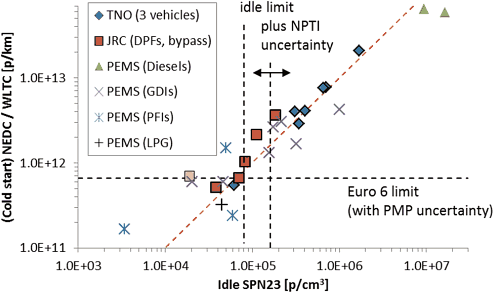European New Periodical Technical Inspection (NPTI)—Status update
9 January 2019
With the introduction of particulate filters on diesel as well as GDI engines, the measurement of particulate emissions during periodic technical inspections (PTI) or for the purpose of road-side checks became a nontrivial task. Opacity and smoke meters—the simple, robust and low cost instruments that were used for this purpose before—do not have sufficient sensitivity to identify particulate filter failures or tampering on new, low emission internal combustion engines. Recent studies conducted in the Netherlands, Switzerland and Belgium have shown that about 10% of passenger cars equipped with diesel particulate filters (DPF) have high PN emissions that could indicate a damaged or removed DPF.
To address this problem, the VERT Association launched a New Periodic Technical Inspection (NPTI) initiative to develop a simple, robust and tamper-proof method for checking the functionality of DPFs using particle number (PN) instruments. The NPTI initiative, launched in November 2016, is supported by the European Union as well as the governments of Germany, the Netherlands, Belgium, and Switzerland.
An NPTI proposal developed by VERT and TNO was summarized in a white paper presented at the 2017 ETH Conference. The proposed test is conducted at idle using a PN instrument. It is assumed that the process will be suitable with minor, if any, modifications for petrol engines. The test protocol is also appropriate for road-side inspections, such as by the police.
The instrumentation is under development by about eight PN specialized manufacturers from the USA, UK, Germany, Finland, and Switzerland. VERT expects the first prototype instruments to be unveiled in workshops in the mid-2019.
The first results are promising, according to a recent JRC study. Instruments in their prototype stage are already capable of recognizing vehicles that have been manipulated using partial bypass that resulted in SPN23 emissions close to maximum allowed type approval levels (i.e., 6×1011 1/km) (Figure 1) and present a satisfactory correlation with SPN PEMS compliant instrumentation. Work on the testing procedure and pass/fail limit is still ongoing. This work is also under the evaluation of the CITA (International Motor Vehicle Inspection Committee) Roadworthiness Technical Working Group which focuses on the roadworthiness aspects of tampering with exhaust emission control systems.
The JRC study summarized the results from different studies, Figure 1: (1) TNO study at low idle with three vehicles; (2) JRC NPTI instruments pre-evaluation with one DPF equipped vehicle with bypass at low idle; and (3) SPN-PEMS evaluation study using idle data of the NEDC and WLTC.

(Source: JRC)
The results show a medium correlation between emission levels during the type approval cycle (NEDC/WLTC) and low idle emissions even with SPN-PEMS instruments. The scatter further increases when first generation NPTI instruments are included. Any low idle limit has to take into account this scatter, but these results suggest that the technical specifications of NPTI instruments should have acceptable uncertainty, with low cost.
The Netherlands and Germany have already started programs that would eventually lead to the adoption of mandatory NPTI emission testing requirements. NMI, the Dutch metrology institute, has released a draft International Recommendation with the specifications of the PTI particulate number counter. The NPTI DPF test may become available in the Netherlands at RDW test stations as soon as 2019, while the nationwide target date for the introduction of NPTI testing is 2021, according to VERT.
In Germany, the Federal Council passed a law in September 2017 (published in the German StVZO 2017) that re-introduces PTI tailpipe emission tests for gaseous pollutants effective from January 2018 (NOx is currently excepted). PN measurements at idle are to be required from 2021.
Chances are the NPTI test could be also used for the control of in-use emissions from nonroad mobile machinery (NRMM) fulfilling the EU Stage V emission standards that include a PN emission limit for a number of engine categories.
Source: VERT Association